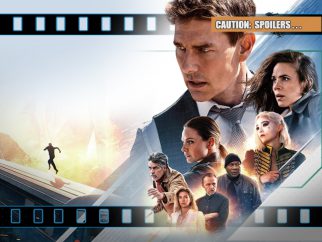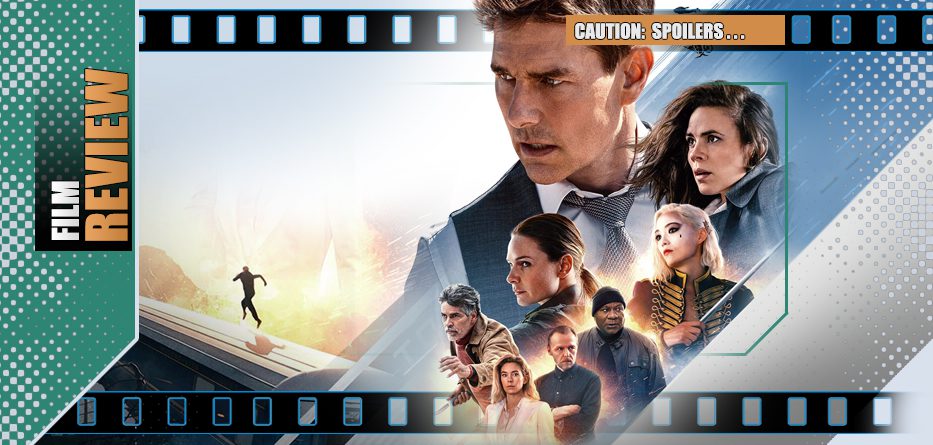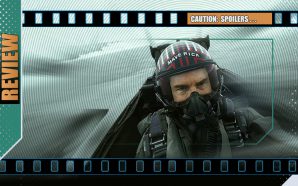In the Arctic, the Russian nuclear submarine Sebastopol appears to be attacked by an unknown external enemy, but realises – too late – that the problem comes from within their own systems.
Fake news takes on a whole new meaning when it turns out that an AI program (or someone behind it) has flexed its virtual muscles, infiltrating systems across the planet and rather than stealing secrets has simply been collating or distorting that electronic information to the extent that every single government on the planet is breaking out in a cold sweat and working out ways of plausible deniability. The US intelligence services are hard-copying as much of its information as possible because – after years of going digital it’s realising that it Is far harder to change a document that is under secure lock and key than it is switch around bits of data linked to a global network.
Ethan Hunt’s mission – should he choose to accept it – is to find a literal key that might unlock the way to stop the system from gaining more control – but when that key could provide the way to ‘kill’ the machine or control it, there are many in the international community who would rather it be the latter.
Now, Hunt and his team are on their own, unable to distinguish supposed allies or enemies from each other and finding out that their new enemy may not be just physical but an entity that can reach out in nanoseconds and change their perception of what is right and what is necessary…
*spoilers*
Sometimes the real world catches up with fiction just a little too fast, so the fact that the latest Mission Impossible entry opens up with a submarine deep beneath the waves and suddenly involves a cataclysmic event that kills everyone onboard is surely the kind of Hollywood happenstance that acts as coincidence. No, Mission Impossible: Dead Reckoning (Part One) is not going to be the best movie ever made, but it is an outing that utterly understands the action genre and specifically the modern MI mission statement and how to execute it all with extreme prejudice and streamline style. One can argue it’s sometimes messy, chaotic, opportunistic and that not all the pieces fit together neatly or without gaps and leaps of faith, but the result is still a glistening, kinetic time-piece that tics down like a bomb or a Swiss-watch with one singular intent: to entertain – everything else is secondary objective, including physics. From the moment Lalo Shifren’s iconic refrain starts pulsing out, you’re in it to win it.
Cruise does what Cruise does. Even the loudest critic of some of his wilder off-screen beliefs and actions would be pushed to detract from his utter commitment to his roles and by all accounts he’s a production leader and has a work-ethic that he encourages through the whole cast and crew. Dead Reckoning says ‘let Cruise be Cruise’ and he does everything expected of him here and more. He may not have the physical weight of a Stallone, or Schwarzenegger but he’s proven he has the tenacity and staying power that haven’t devolved into parody. Hayley Atwell, who carved such a strong and capable niche as the MCU‘s Peggy Carter continues to show why she should have her own franchise. Here she may be a damsel in distress for Cruise to save on a regular basis, but she gives us a character, Grace, who works well under pressure and doesn’t sit around waiting to be saved. It’s a production that asks a lot of her physically (the actor commented she sometimes spent some weeks on set filming sequences that required her to run rather than talk) but she masters both the dialogue and the drama and absolutely holds her own – likely for even more of a pro-active role in Part Two.
Rebecca Ferguson (a steadily rising star with slow-burn, long-game charisma and in-demand given her Silo and Dune duties) provides some of the connective tissue in the first half of the film, the current holder of the ‘maguffin’ of the piece (that pesky key that unlocks the biggest threat to humanity). Hunt is sent in to get her and that key, though it’s only the start of the chaos the object will cause as everyone scrambles to get it. Elsewhere both Simon Pegg and Ving Rhames (reprising their roles of Benjie and Luther) also give it their all in steadfast supportive roles. Henry Czerny returns as duplicitous, self-serving boss Kittridge, Vanessa Kirby reprises her White Witch arms-dealer and Shea Whigham’s Briggs (along with Greg Tarzan Davis as his partner Degas) are swept along as government operatives determined to bring Hunt in but also starting to question the other agendas at play. Our main human baddie is Esai Morales’ Gabriel with an invented back-story stretching back to Hunt’s pre-IMF days, though the often-underrated Morales isn’t really given much room to expand beyond’ nemesis’ description. Guardians of the Galaxy‘s more-than-able Pom Klementieff essays a henchwoman called Paris who gives everyone a hard time.
Directed with the expected flair by the returning Christopher McQuarrie, the actual script has a lot of expository dialogue, profound in its delivery as it is unlikely, but mostly staying just the right side of annoyingly pompous because, hey, this is Mission Impossible and its going to earn it. Ethan Hunt is poetically described by his pursuers as “… a master of infiltration, deception, sabotage and psych-warfare – for all intents and purposes a mind-reading, shape-shifting incarnation of chaos...” and Pegg’s Benji notes of their virtual enemy, that it is “A self-aware, self-learning, truth-eating digital parasite infesting all of cyberspace. Well, it was bound to happen sooner or later…”
Several plot points and set-pieces are powered by the overt cinematic convenience needed to keep the plot barreling along so you don’t question the joins in the moment. We’ve come to expect the ambitious and stylish from the Mission Impossible franchise and that star Tom Cruise will push himself and the production to go beyond the scope of all other action outings. Much was made of his parachuting escapades in the marketing of this film and how Cruise tacks into the wind of extreme sports and puts himself, rather than a stuntman, in the frame where possible. All of that is on show, but some of that is also marketing – Cruise does indeed do a lot of the work himself, but trains well and hard for it rather than being reckless, with likely every stunt having safety precautions that would bankrupt entire industries – but I’m pretty sure insurance policies forbid some of the situations and modern technology can enhance more than ever before. Nevertheless, as an audience-member there’s points where, as you watch, you may be impressed by what must be CGI and good editing, but you never doubt that it’s Cruise/Hunt at the heart of it all. Yes, in a movie packed with such, some set-pieces are better than others. Like the recent Indy outing, Dial of Doom, the race through windy back-streets of a foreign city in a small, unsuitable vehicle is fun yet out-stays its welcome just a little… but is well-choreographed and full of enough fun beats that it’s easily forgivable and if, by the time we get to the big train stunts that end this chapter, even the biggest fan may be a little weary and dizzy, the gravity-defying climb through carriages to safety remains inventive.
There are a few frustrating disconnects where you suspect scenes have been shortened or snipped out. Hayley Atwell escapes Abu Dhabi airport – just out of reach of Ethan Hunt – and the next scene she’s under arrest in Italy where Hunt arrives as her ‘lawyer’. We haven’t really missed any story, but inconsistent time has passed and it shows how eager the film is to keep up the pace rather than the geography.
Mission Impossible: Dead Reckoning (Part One) sticks to its formula of shock-and-awe archetypes, all silly, stylish and sprinting through a marathon of sy-fi endurance, oozing confidence in every frame. On that front, it’s hard to ask for better escapism.

- Story8
- Acting8
- Direction9
- Production Design / VFX10











